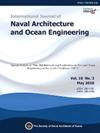Experimental study of the steady-state and dynamic characteristics of 1 kW water-cooled PEMFC
IF 3.9
3区 工程技术
Q2 ENGINEERING, MARINE
International Journal of Naval Architecture and Ocean Engineering
Pub Date : 2024-01-01
DOI:10.1016/j.ijnaoe.2024.100620
引用次数: 0
Abstract
The Polymer Electrolyte Membrane Fuel Cell (PEMFC) has been widely developed in the shipping sector, prompting the need to accurately understand its characteristics under various operating conditions and load variations. This study presents an experimental investigation into the steady-state and dynamic characteristics of a 1 kW water-cooled PEMFC stack, aiming to optimize reactant consumption and to assess the PEMFC voltage response under varying load conditions. In the steady-state tests, experiments were conducted at three different stoichiometries of hydrogen and air to evaluate the effect of stoichiometry on PEMFC efficiency. The results showed that the electrical efficiency improved by 10% at lower hydrogen stoichiometry (1.2) compared to the manufacturer's recommended values (1.6). In the dynamic tests, the behaviors of undershoot voltage and open circuit voltage (OCV) were examined using load-step and load-ramp conditions. Results showed that the undershoot voltage could be reduced either by narrowing the load step size and ramp rate or by implementing a reactant supply strategy, which increasing the gas flow rates before increasing the current. A consistent 0.55 V recovery was observed at the OCV after 10 s, regardless of the step sizes or ramp rates of load, indicating that the PEMFC was in good state of health after dynamic load conditions. OCV can serve as an effective diagnostic tool for assessing PEMFC health.
1 kW 水冷 PEMFC 稳态和动态特性的实验研究
聚合物电解质膜燃料电池(PEMFC)已在航运领域得到广泛应用,因此需要准确了解其在各种运行条件和负载变化下的特性。本研究对 1 千瓦水冷式 PEMFC 堆的稳态和动态特性进行了实验研究,旨在优化反应剂消耗,并评估 PEMFC 在不同负载条件下的电压响应。在稳态测试中,对氢气和空气的三种不同化学计量进行了实验,以评估化学计量对 PEMFC 效率的影响。结果表明,与制造商的推荐值(1.6)相比,氢气比例较低(1.2)时,电效率提高了 10%。在动态测试中,使用负载阶跃和负载斜坡条件对欠压和开路电压(OCV)的行为进行了检验。结果表明,可以通过缩小负载阶跃大小和斜率,或通过实施反应剂供应策略(在增加电流之前提高气体流速)来降低欠压。无论负载的步长或斜率如何,10 秒后都能在 OCV 上观察到一致的 0.55 V 恢复电压,这表明 PEMFC 在动态负载条件下处于良好的健康状态。OCV 可以作为评估 PEMFC 健康状况的有效诊断工具。
本文章由计算机程序翻译,如有差异,请以英文原文为准。
求助全文
约1分钟内获得全文
求助全文
来源期刊

International Journal of Naval Architecture and Ocean Engineering
ENGINEERING, MARINE-
CiteScore
4.90
自引率
4.50%
发文量
62
审稿时长
12 months
期刊介绍:
International Journal of Naval Architecture and Ocean Engineering provides a forum for engineers and scientists from a wide range of disciplines to present and discuss various phenomena in the utilization and preservation of ocean environment. Without being limited by the traditional categorization, it is encouraged to present advanced technology development and scientific research, as long as they are aimed for more and better human engagement with ocean environment. Topics include, but not limited to: marine hydrodynamics; structural mechanics; marine propulsion system; design methodology & practice; production technology; system dynamics & control; marine equipment technology; materials science; underwater acoustics; ocean remote sensing; and information technology related to ship and marine systems; ocean energy systems; marine environmental engineering; maritime safety engineering; polar & arctic engineering; coastal & port engineering; subsea engineering; and specialized watercraft engineering.
 求助内容:
求助内容: 应助结果提醒方式:
应助结果提醒方式:


